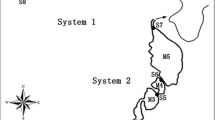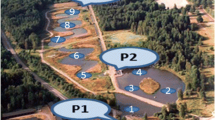Abstract
Wetlands have become the focus of numerous research and restoration efforts due to their ability to assimilate phosphorus and nitrogen from urban wastewater and stormwater runoff. Long-term data collected at Boney Marsh, Florida, USA, and the USEPA wetland database were analyzed to develop a simple tool that can be used to predict and optimize phosphorus retention in wetland treatment systems. Wetland properties such as water loading rate, water depth, P-loading rate, and water retention time were examined for their influence on phosphorus retention. The relationship between wetland properties and phosphorus removal efficiency was reduced to a simple quantitative diagram, 'The Phosphorus Removal Efficiency Diagram.′ The proposed diagram provides a simple management tool that predicts expected treatment range using controllable hydrologic conditions.
The author uses the editor′s suggestion for abbreviation.
Similar content being viewed by others
References
de Jong, J., 1976. The purification of wastewater with the aid of rush or reed ponds. Biological Control of Water Pollution J. Tourbier & R.W. Pierson (eds), University of Pennsylvania Press, Philadelphia: 133-139.
Golden Software, Inc., 1990. Surfer Reference Manual. Golden, Colorado, USA, 260 pp.
Golterman, H. L., 1998. The distribution of phosphate over ironbound and calcium-bound phosphate in stratified sediments. Hydrobiologia 364: 75-81.
Golterman, H. L., J. Paing, L. Serrano, & E. Gomez, 1998a. Presence of and phosphate release from polyphosphate of phytate phosphate in lake sediments. Hydrobiologia 364:99-104.
Golterman, H. L., P. Bruijn, J. G. M. Schouffoer, & E. Dumoulin, 1998b. Urea fertilization and the N-cycle of rice-fields in the Camargue (S. France). Hydrobiologia 384: 7-20.
Howard-Williams, C., 1985. Cycling and nutrient retention of nitrogen and phosphorus in wetlands: a theoretical and applied perspective. Freshwat. Biol. 15: 391-431.
Holdren, G. C., & D. E. Armstrong, 1980. Factors affecting phosphorus release from intact lake sediment cores. Envir. Sci. Technol. 14: 79-87.
Jones, A. & G. F. Lee, 1980. An approach for the evaluation of efficiency of wetlands-based phosphorus control programs for eutrophication related water quality improvement in downstream water bodies. Water, Air & Soil Pollution 14: 359-378.
Kadlec, R. H., 1995. Performance and design of treatment wetlands. In Versatility of Wetlands in agricultural landscape. Tampa, Florida, USA: 571-585.
Kadlec, R. H. & R. L., Knight, 1996. Treatment Wetlands. CRC Press, Boca Raton, Florida, USA.
Kadlec, R. H. & S. Newman, 1992. Phosphorus removal in wetland treatment areas, principles and data. South Florida Water Management District, Technical Publication 92-321, West Palm Beach, FL, USA.
Knight, R. L., R. W. Ruble, R. H. Kadlec, & S. C. Reed, 1992. Wetlands for wastewater treatment performance database. In G. Moshiri (ed.), Constructed Wetlands for Wastewater Treatment. Lewis Publishers, Boca Raton, Florida, USA: 35-58.
McColl, R. H. S., 1979. Chemical runoff from pasture: the influence of fertilizer and riparian zones. New Zeal. J. mar. Freshwat. Res. 12: 371-380.
McCormick, P. V., P. S. Rawlik, K. Lurding, E. P. Smith, & F. H. Sklar, 1996. Periphyton-water quality relationships along a nutrient gradient in the northern Everglades. J. N. am. Benthol. Soc. 15: 433-449.
Mitsch, W. J., 1992. Landscape design and the role of created, restored, and natural riparian wetlands in controlling nonpoint source pollution. Ecol. Eng. 1: 27-47.
Moustafa, M. Z., 1997. Graphical presentation of nutrient removal in constructed wetlands. Wetlands 17: 493-501.
Moustafa, M. Z., M. Chimney, T. D. Fontaine, & G. Shih, 1996. The response of a freshwater wetland to long-term 'low level' nutrient loads. Ecolog. Eng. 7: 15-33.
Mulholland, P. J., L. A., Yarbro, R. P. Sniffen, & E. J. Kuenzler, 1981. Effects of floods on nutrient and metal concentrations in a coastal plain stream. Wat. Res. Res. 17: 758-764.
Nichols, D. S., 1983. Capacity of natural wetlands to remove nutrients from wastewater. J. Wat. Pollut. Cont. Fed. 55: 495-505.
Peverly, J. H., 1982. Stream transport of nutrients through a wetland. J. Envir. Qual. 11: 38-43.
Raschke, R. L., 1993. Diatom (Bacillariophyta) community responses to phosphorus in the Everglades National Park, USA Phycologia 32: 48-58.
Reckhow, K. H., 1979. Empirical lake models for phosphorus: Development, applications, limitations, and uncertainty. In D. Scavia & A. Robertson (eds), Perspectives on Lake Ecosystem Modeling. Butterworth, Stoneham, Mass, USA: 193-221.
Reckhow, K. H. & S. S. Qian, 1994. Modeling phosphorus trapping in wetlands using generalized additive models. Wat. Res. Res. 11: 3105-3114.
Spangler F., W. Sloey, & C. W. Fetter, 1976. Experimental use of emergent vegetation for the biological treatment of municipal wastewater in Wisconsin. In J. Tourbier & R. W. Pierson (eds), Biological Control of Water Pollution. University of Pennsylvania Press, Philadelphia: 161-171.
Swift, D. R., & R. B. Nicholas, 1987. Periphyton and water quality relationships in the Everglades Water Conservation Areas, 1978-1982. Technical Publication 87-2, South Florida Water Management District, West Palm Beach, Florida, 44 pp.
Walker, W. W., 1995. Design basis for Everglades Stormwater Treatment Areas. Wat. Res. Bull. 31: 671-685.
Vollenweider, R. A., 1975. Input-output Models. Schweiz. Z. Hydrologie 37: 53-84.
Author information
Authors and Affiliations
Rights and permissions
About this article
Cite this article
Moustafa, M. Analysis of phosphorus retention in free-water surface treatment wetlands. Hydrobiologia 392, 41–53 (1999). https://doi.org/10.1023/A:1003549206822
Issue Date:
DOI: https://doi.org/10.1023/A:1003549206822




